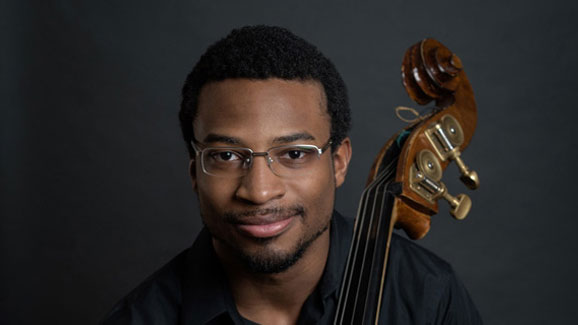Sunday, November 14, 2021 at 4pm
For Justice and
Peace
Season Subscriptions are currently on sale, to purchase call Patron Services 203.325.1407 x10
Questions? Email Patron Services at office@stamfordsymphony.org

Sunday, November 14, 2021 at 4pm
For Justice and
Peace
Season Subscriptions are currently on sale, to purchase call Patron Services 203.325.1407 x10
Questions? Email Patron Services at office@stamfordsymphony.org

Sunday, November 14, 2021 at 4pm
For Justice and
Peace
Season Subscriptions are currently on sale, to purchase call Patron Services 203.325.1407 x10
Questions? Email Patron Services at office@stamfordsymphony.org

Time to event
Duration
75 minutes
no intermission
Share With
About this performance:
Opening night includes a profound work for our time by African American composer Xavier Foley. For Justice and Peace was created to mark the 400 years of slavery with the arrival of the slave ship White Lion in Jamestown. Also on the program, optimistic, vivacious and fun works by Prokofiev and Bizet.
Please note that in order to provide a safe concert experience the following protocols are in place.
-
Proof of being fully vaccinated against COVID-19 or a negative COVID test.
Fully vaccinated means, on the day of the show, the person is at least 14 days after their second dose of an FDA or WHO approved two-dose COVID-19 vaccine (such as the BioNTech, Pfizer, or Moderna vaccines) or at least 14 days after their single dose of an FDA or WHO approved single-dose COVID-19 vaccine (such as the J&J vaccine). Proof of vaccination must come directly from the healthcare provider who administered the vaccination. Patrons may display proof on a smartphone or present a physical copy.
A negative COVID test must be either a negative COVID-19 antigen test taken within 6 hours of the performance start time or a negative COVID-19 PCR test taken within 72 hours of the performance start time and administered by an official healthcare provider.
-
In addition, a government-issued photo ID, such as a driver’s license or passport, will be accepted for all patrons 18 years and older. Patrons younger than 18 may use a government-issued photo ID or school photo ID. An adult who meets the above requirements must accompany patrons under 12. In addition, a valid ticket is also required for admission.
-
Masks are required for the duration of your time at the Palace Theatre.
-
Patrons must follow all posted instructions at the Palace Theatre.
-
Contactless ticket scanning.
-
There will not be an intermission during this shorter program.
Musical Program to include:
Prokofiev Symphony No.1 Classical
Xavier Foley For Justice and Peace
Eunice Kim, violin
Xavier Foley, double bass
Bizet Symphony in C
Michael Stern, conductor
A Message From Music Director Michael Stern
Featured Artists:
Xavier Foley, double bass

Xavier Foley is known for communicating his virtuosity and passion for music on the double bass, which is rarely presented as a solo instrument. Winner of a prestigious 2018 Avery Fisher Career Grant, he was recently recognized on New York WQXR’s “19 for 19” Artists to Watch list, and featured on PBS Thirteen’s NYC-ARTs.
Also a composer, Mr. Foley was co-commissioned by Carnegie Hall and the Sphinx Organization for a new work entitled “For Justice and Peace” for Violin, Bass, and String Orchestra, which was recently performed at venues including Carnegie Hall as part of a program designed to promote social justice.
As concerto soloist with orchestra, he has performed with the Atlanta Symphony, Philadelphia Orchestra, Nashville Symphony, Brevard Concert Orchestra, Victoria Symphony, Sphinx Symphony and Sphinx Virtuosi at Carnegie Hall.
Mr. Foley won the 2016 Young Concert Artists International Auditions along with four Performance Prizes and a Paiko Foundation Fellowship, and First Prizes at Astral’s 2014 National Auditions, Sphinx’s 2014 Competition, and the 2011 International Society of Bassists Competition.
In 2018, he made his acclaimed New York recital debut at Merkin Concert Hall and his Washington, DC debut at the Kennedy Center’s Terrace Theater on the Young Concert Artists Series. The program included two of his own compositions. He has also performed at Carnegie Hall as a Laureate of the Sphinx Competition, at the Young Concert Artists Series at Alice Tully Hall and the Morgan Library, and for Boston’s Isabella Stewart Gardner Museum, Paramount Theatre in Vermont, Harriman-Jewell Series in Missouri, and Buffalo Chamber Music Society. This season, invitations for Mr. Foley to perform include Arizona Friends of Chamber Music, Alys Stevens Performing Arts Center, Shriver Hall Discovery Series, Virtuosi Concert Series of Winnipeg, as well as the Zenith and Bridgehampton Chamber Music Festivals.
An active chamber musician, Mr. Foley has appeared at the Marlboro Music Festival, Tippet Rise Music Festival in Fishtail, MT, Bridgehampton and Skaneateles (NY) Festivals, New Asia Chamber Music Society in Philadelphia, South Mountain Concerts, Wolf Trap, and with New York’s Jupiter Chamber Players.
A native of Marietta, GA, Xavier Foley is an alumnus of the Perlman Music Program, and earned his Bachelor of Music from the Curtis Institute of Music working with Edgar Meyer and Hal Robinson. His double bass was crafted by Rumano Solano.
Eunice Kim, violin








